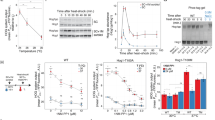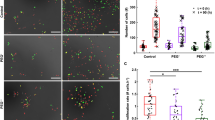Abstract
The exposure of CHO DG44 cells to an osmotic shock, after DNA uptake, results in a cellular volume decrease of approx. 55%. Repetitive osmotic shocks targeted different sub-populations of cells as was demonstrated using two different fluorescent reporter genes. Also the exposure of a calcium phosphate–DNA coprecipitate to high osmolarity in vitro caused the release of the DNA from the precipitate. The results demonstrate the importance of the osmotic shock on the efficient delivery of plasmid DNA to the nucleus of CHO cells following calcium phosphate-mediated transfection.






Similar content being viewed by others
References
Batard P, Jordan M, Wurm F (2001) Transfer of high copy number plasmid into mammalian cells by calcium phosphate transfection. Gene 270:61–68
Brunner S, Sauer T, Carotta S, Cotten M, Saltik M, Wagner E (2000) Cell cycle dependence of gene transfer by lipoplex, polyplex and recombinant adenovirus. Gene Ther 7:401–407
Capecchi MR (1980) High efficiency transformation by direct microinjection of DNA into cultured mammalian cells. Cell 22:479–488
Dowty ME, Williams P, Zhang G, Hagstrom JE, Wolff JA (1995) Plasmid DNA entry into postmitotic nuclei of primary rat myotubes. Proc Natl Acad Sci USA 92:4572–4576
Graham FL, Van Der Eb AJ (1973) A new technique for the assay of infectivity of human adenovirus 5 DNA. Virology 52:456–467
Grosjean F, Batard P, Jordan M, Wurm F (2002) S-phase synchronized CHO cells show elevated transfection efficiency using CaPi. Cytotechnology 38(1–3):57–62
Jordan M, Schallhorn A, Wurm F (1996) Transfecting mammalian cells: optimization of critical parameters affecting calcium-phosphate precipitate formation. Nucl Acids Res 24:596–601
Lechardeur D, Sohn KJ, Haardt M, Joshi PB, Monck M, Graham RW, Beatty B, Squire J, O’Brodovich H, Lukacs GL (1999) Metabolic instability of plasmid DNA in the cytosol: a potential barrier to gene transfer. Gene Ther 6:482–497
Loyter A, Scangos G, Juricek D, Keene D, Ruddle FH (1982a) Mechanisms of DNA entry into mammalian cells. II. Phagocytosis of calcium phosphate DNA co-precipitate visualized by electron microscopy. Exp Cell Res 139:223–234
Loyter A, Scangos G, Ruddle FH (1982b) Mechanisms of DNA uptake by mammalian cells: fate of exogenously added DNA monitored by the use of fluorescent dyes. Proc Natl Acad Sci USA 79:422–426
Mortimer I, Tam P, MacLachlan I, Graham RW, Saravolac EG, Joshi PB (1999) Cationic lipid-mediated transfection of cells in culture requires mitotic activity. Gene Ther 6:403–411
O’Mahoney JV, Adams TE (1994) Optimization of experimental variables influencing reporter gene expression in hepatoma cells following calcium phosphate transfection. DNA Cell Biol 13:1227–1232
Orrantia E, Chang PL (1990) Intracellular distribution of DNA internalized through calcium phosphate precipitation. Exp Cell Res 190:170–174
Sabelnikov AG (1994) Nucleic acid transfer through cell membranes: towards the underlying mechanisms. Prog Biophys Mol Biol 62:119–152
Wake CT, Gudewicz T, Porter T, White A, Wilson JH (1984) How damaged is the biologically active subpopulation of transfected DNA? Mol Cell Biol 4:387–398
Wilke M, Fortunati E, Van Den Broek M, Hoogeveen AT, Scholte BJ (1996) Efficacy of a peptide-based gene delivery system depends on mitotic activity. Gene Ther 3:1133–1142
Acknowledgments
The authors would like to thank ZLB Bioplasma AG in Bern, Switzerland for financial support of this work.
Author information
Authors and Affiliations
Corresponding author
Rights and permissions
About this article
Cite this article
Grosjean, F., Bertschinger, M., Hacker, D.L. et al. Multiple glycerol shocks increase the calcium phosphate transfection of non-synchronized CHO cells. Biotechnol Lett 28, 1827–1833 (2006). https://doi.org/10.1007/s10529-006-9167-7
Received:
Accepted:
Published:
Issue Date:
DOI: https://doi.org/10.1007/s10529-006-9167-7




